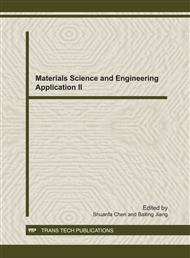[1]
E. Salehi, S.S. Madaeni. Adsorption of humic acid onto ultrafiltration membranes in the presence of protein and metal ions. Desalination . Vol. 263 (2010) , p.139.
DOI: 10.1016/j.desal.2010.06.050
Google Scholar
[2]
A.S. Koparal, Y.S. Yildiz, B. Keskinler, N. Demircioglu, Effect of initial pH on the removal of humic substances from wastewater by electrocoagulation, Sep. Purif. Technol. Vol. 59(2008), p.175.
DOI: 10.1016/j.seppur.2007.06.004
Google Scholar
[3]
Ö. Gök, A. Özcan, B. Erdem, A.S. Özcan, Prediction of the kinetics, equilibrium and thermo- dynamic parameters of adsorption of copper(II) ions onto 8-hydroxy quinoline immobilized bentonite, Colloids Surf., A 317 (2008)174-185.
DOI: 10.1016/j.colsurfa.2007.10.009
Google Scholar
[4]
W.S. Wan Ngah, S. Fatinathan, N.A. YosopIsotherm and kinetic studies on the adsorption of humic acid onto chitosan-H2SO4 beads. Desalination 272 (2011) 293-300.
DOI: 10.1016/j.desal.2011.01.024
Google Scholar
[5]
T.S. Anirudhan,M. Ramachandran, Surfactant-modified bentonite as adsorbent for the removal of humic acid from wastewaters, Appl. Clay Sci. 35 (2007)276-281.
DOI: 10.1016/j.clay.2006.09.009
Google Scholar
[6]
S. Vreysen, A. Maes, Adsorptionmechanismof humic and fulvic acid ontoMg/A layered double hydroxides, Appl. Clay Sci. 38 (2008) 237-249.
DOI: 10.1016/j.clay.2007.02.010
Google Scholar
[7]
F. Hua-Jun, H. Li-Fang, M. Qaisar, L. Yan, S. Dong-Sheng, Study on biosorption of humic acid by activated sludge, Biochem. Eng. J. 39 (2008) 478-485.
Google Scholar
[8]
T.S. Anirudhan, P.S. Suchithra, Humic acid-immobilized polymer/bentonite composite as an adsorbent for the removal of copper(II) ions from aqueous solutions and electroplating industry wastewater, J. Ind. Eng. Chem. 16 (2010)130-139.
DOI: 10.1016/j.jiec.2010.01.006
Google Scholar
[9]
E.S.Z. El-Ashtoukhy, N.K. Amin, O. Abdelwahab, Removal of lead (II) and copper (II) from aqueous solution using pomegranate peel as a new adsorbent, Desalination. Vol. 223 (2008), p.165.
DOI: 10.1016/j.desal.2007.01.206
Google Scholar
[10]
L. Zhao, F. Luo, J.M. Wasikiewicz, H. Mitomo,N. Nagasawa, T. Yagi, M. Tamada, F. Yoshii, Adsorption of humic acid from aqueous solution onto irradiation crosslinked carboxy methyl chitosan, Bioresour. Technol. 99 (2008), p. (1915).
DOI: 10.1016/j.biortech.2007.03.030
Google Scholar
[11]
W.L. Yan, R. Bai, Adsorption of lead and humic acid on chitosan hydrogel beads, Water Res. Vol. 39 (2005), p.688.
DOI: 10.1016/j.watres.2004.11.007
Google Scholar
[12]
M.N. Jones N.D. Bryan, Colloidal properties of humic substances, Adv. Colloid Interface Sci. Vol. 78 (1998), p.18.
Google Scholar
[13]
K.L. Jones C.R. O'Melia, Protein and humic acid adsorption onto hydrophilic membrane su- rfaces: effects of pH and ionic strength, Journal of Membrane Science . 165 (2000), p.31.
DOI: 10.1016/s0376-7388(99)00218-5
Google Scholar
[14]
W.S. Wan Ngah, M.A.K.M. Hanafiah, S.S. Yong. Adsorption of humic acid from aqueous solutions on crosslinked chitosan–epichlorohydrin beads: Kinetics and isotherm studies. Colloids and Surfaces B: Biointerfaces 65 (2008) p.18.
DOI: 10.1016/j.colsurfb.2008.02.007
Google Scholar
[15]
S. Wang, Z.H. Zhu. Humic acid adsorption on fly ash and its derived unburned carbon, J. Colloid Interface Sci. 315 (2007) p.46.
DOI: 10.1016/j.jcis.2007.06.034
Google Scholar
[16]
S. Deng,R. Bai, Adsorption and desorption of humic acid on aminated poly acrylonitrilefibers, J. Colloid Interf. Sci. 280 (2004) p.36.
Google Scholar


